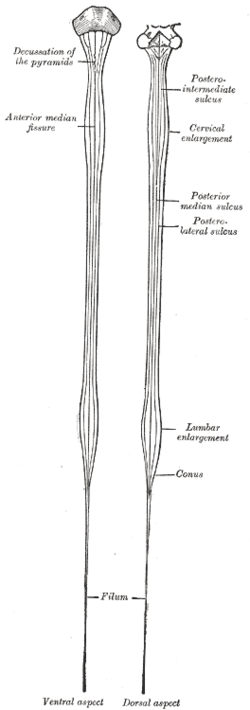Lumbar enlargement
Appearance
| Lumbar enlargement | |
|---|---|
 Diagrams of the medulla spinalis. (Cervical enlargement labeled at center right.) | |
| Details | |
| Identifiers | |
| Latin | intumescentia lumbosacralis |
| TA98 | A14.1.02.003 |
| TA2 | 6051 |
| FMA | 74895 |
| Anatomical terminology | |
The lumbar enlargement (or lumbosacral enlargement) is a widened area of the spinal cord that gives attachment to the nerves which supply the lower limbs.
It commences about the level of T11 and ends at L2, and reaches its maximum circumference, of about 33 mm. Inferior to the lumbar enlargement is the conus medullaris.[1]
An analogous region for the upper limbs exists at the cervical enlargement.
Additional images
-
Spinal cord. Spinal membranes and nerve roots.Deep dissection. Posterior view.
References
![]() This article incorporates text in the public domain from page 752 of the 20th edition of Gray's Anatomy (1918)
This article incorporates text in the public domain from page 752 of the 20th edition of Gray's Anatomy (1918)
External links
- lesson6spinalcord&coverings at The Anatomy Lesson by Wesley Norman (Georgetown University)
- Anatomy photo:02:08-0102 at the SUNY Downstate Medical Center - "Vertebral Canal and Spinal Cord: Regions of the Spinal Cord"
- Atlas image: n3a5p3 at the University of Michigan Health System - "Spinal Cord, Fetus, Posterior View"

